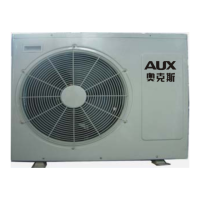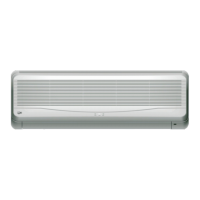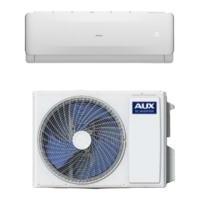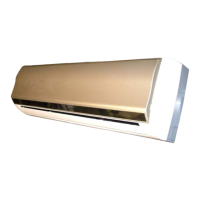AUX air conditioner service manual
203
Cause Analysis: turned on the air conditioner, it could run normally. Checked filter of indoor unit and
heat exchangers, and found that they were quite clean and wouldn’t impact the cooling efficiency.
Checked capacitors and all parameters of indoor and outdoor fans, voltage was 220v, current was
13.5A, low pressure was 0.4MPa and there’s no extension line, outdoor compressor also run normally,
in addition, no flow restriction was found. After air conditioner run about 20 minutes, measured
current and pressure: current became 15A, system pressure became 0.3MPa, refrigerating efficiency
became worse. According to the data, we presumed that system was blocked or flow was restricted
somewhere. We checked the connection line between indoor and outdoor units and didn’t find flow
restriction. So we checked outdoor unit, and found two groups of capillaries connecting distributor
were frosted, so we believed that there’s some problem on the capillary. Separated the distributor and
capillaries and found that filter net in the distributor was blocked by oil sludge and foreign substance,
but hadn’t been blocked up, so flow in the capillary should be sufficient and caused flow restriction
and frost.
Solution: replace new distributor, purge the system with nitrogen, vaccumize the system, and then fill
refrigerant in the system; air conditioner functions well since then.
Experience Conclusion: to air conditioner with relatively poor cooling performance, we should
consider all conditions comprehensively and have clear philosophy: check from main to secondary,
from inside to outside and from outer to inner; following aspects shall be considered:
1. Check whether air conditioner works well;
2. Check heat exchange condition of outdoor and indoor units, consider the interference of
surrounding appliances;
3. Outdoor and indoor fan velocity will impact heat exchange;
4. Measure all parameters and judge if they’re normal, and analyze reasons;
5. Consider impact of extended tube on the performance of air conditioner;
6. Consider interruption of running of indoor and outdoor compressor;
7. Check if there’s no throttle in the system, and consider impact of cold flow on cooling performance.
Case 3: Capillary of separator of indoor unit evaporator is blocked
Unit Model: ASF-41A5/A
Phenomena: Poor cooling efficiency
Cause Analysis: this air conditioner was brand new, indoor and outdoor units were very clean and
ventilate normally; service power functioned well, indoor unit air outlet well; but we found that
temperature difference of air inlet and outlet of indoor unit was relatively low; checked connection
pipe of outdoor and found that low pressure tube was frosted, so we presumed that refrigerant in the
system was excessive, so we released some Freon and refrigerating efficiency became worse; so we
judged that there’s flow restriction in the system; opened the panel of indoor unit, touched evaporator,
and found that temperature difference of upper and down part of evaporator was obviously large.
Touched capillary of evaporator of indoor unit, found that two groups of capillaries were slightly
frosted. So faults were caused by block in capillaries.
Solution: removed capillaries with welding machine, found that capillary outlet was blocked by weld
liquid. Replaced capillaries and air conditioner functioned well since then.
Experience Conclusion: according to phenomena, we presumed there’s excessive refrigerant; when we
